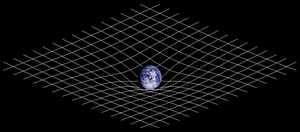Graviton facts for kids
A graviton is a hypothetical particle that 'transfers' gravitation's force (particles like this are known as gauge bosons) from its field. Gravitons have never been observed, directly or indirectly, however, there have been several theories that use gravitons to explain certain phenomena. For example, a theory that describes black holes by combining quantum mechanics and gravity, has been advanced by Georgi Dvali and Cesar Gomez, which suggests a black hole is "an overpacked bucket of gravitons". There are some theories that suggest that gravitons would make up a new group of particles, "attraction particles". CERN is currently smashing more particles using the Large Hadron Collider to try to find this particle.
The graviton applies a tiny force as it impacts the nuclei of atoms. All atoms themselves have these graviton particles in orbit around them. If you gather a lot of atoms together the population of orbiting gravitons increases proportionately. As a result, a large asteroid for example will have more gravity than a small one. Because the graviton is a particle that has force (gravity), it is classed as a gauge boson. Other gauge bosons include the photon, the gluon, and the W and Z particles.
If someone found one, it could lead to a theory which would join together the four main physical forces: electromagnetism, gravity, strong force and weak force.
See also
 In Spanish: Gravitón para niños
In Spanish: Gravitón para niños


